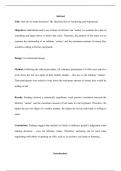Other
Quantitative Research: The Heuristic Bias of Anchoring-and-Adjustment
- Institution
- Coventry University (West Midlands) (CU)
ASSIGNMENT TYPE: coursework *quantitative research paper on secondary data Overall grade = 72% Design: correlational design used to examine the relationship of an arbitrary ‘anchor’ and the maximum amount of money they would be willing to bid for a keyboard.
[Show more]



